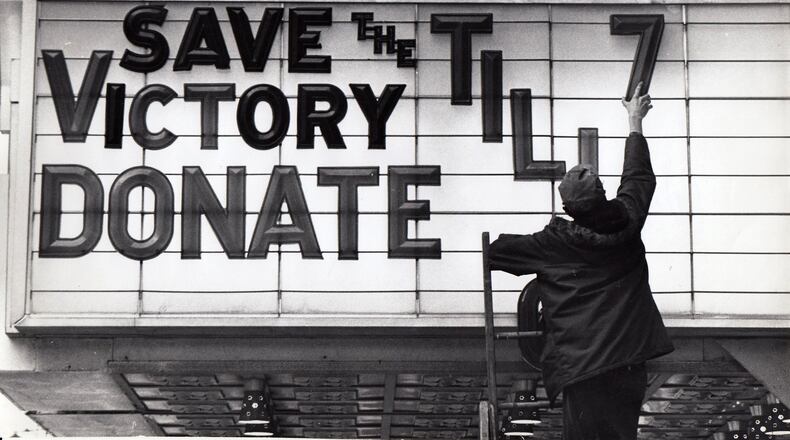The lot, construction and furnishings cost brothers Joseph and William Turner $325,000. The opera house seated 1,300 and the auditorium was decorated in blue and gold with 40-foot-tall fresco ceilings.
A devastating fire in 1869 destroyed the theater, leaving only the facade facing Main Street after only a few years of performances by thespians, minstrels and comedic burlesque shows.
Credit: Lisa Powell
Credit: Lisa Powell
New investors rebuilt the theater in 1871 and the operatic soprano Euphrosyne Parepa Rosa opened the newly named Music Hall. Tickets cost $1.50 each and boxes were $10.
Elaborate theatrics and famous actors held audiences spellbound. Live horses galloped in a chariot race staged on a conveyor belt in the theatrical adaption of “Ben-Hur” in 1904. Giant cylinders moved a 52-foot-high by 2006 feet long Roman scenery panorama in the background while fans blew the chariot riders hair back for added affect.
Buffalo Bill Cody played the Music Hall more than seven times, Mark Twain and Oscar Wilde lectured to the crowds and the magician Harry Houdini disappeared from stage in 1925 using an air shaft to escape a box built by National Cash Register carpenters.
The Great Flood of 1913 destroyed the interior of the theater but the exterior stood. It was refurbished and opened again as the New Victoria Nov. 25, 1913. Five years later a second fire destroyed the building. Near the end of 1919 the rebuilt Victory Theatre, named after those who fought and died in WWI, was opened by William A. Keyes.
During Keyes ownership audiences continued to enjoy live performances as well as motion pictures. Lines formed around the Victory in the 1950s and 1960s to see Hayley Mills in “The Parent Trap” and other classic Disney films like “Swiss Family Robinson ” and “101 Dalmations.”
Credit: Lisa Powell
Credit: Lisa Powell
Keyes died in 1955 and left the theater to his family. Tess Servaites of Englewood and her cousin Jeanne Beachler of Miami Twp. are the grand-daughters of William Keyes. The two grew up in the Victory Theatre.
“I remember going to the theater before it opened on Saturdays and standing in the spotlight on the stage,” said Servaites. “My sisters and I would pretend we were big stars.”
Her cousin Beachler recalled sneaking out of school dances with her friends to watch Godzilla movies at the theater.
The suburbs became the place to be in the early 1970s. Theaters with free parking were popping up and fewer people came downtown. The Victory’s books were in the red and in 1971 the Keyes family make the painful decision to close.
The upcoming United States bicentennial inspired the community to begin to appreciate the past and helped motivate a small group of young volunteers to start the “Save the Victory” committee.
“At the time we started ‘Save the Victory’ the Lowe’s theater downtown across from the Victory was being demolished,” said Fred Bartenstein of Yellow Springs, one of the founding members. “The wrecking ball was literally out on the sidewalk,” he said.
Credit: Lisa Powell
Credit: Lisa Powell
The greater community rallied around the organization. A local radio D.J. put out a call to listeners to head downtown to volunteers along Main Street. “People were driving by and handing money out of their car windows for donations,” said Bartenstein. The wrecking ball was kept at bay.
That grassroots effort led to buy-in from the greater community. Local philanthropists, foundations and community leaders rallied behind the project and raised enough money to at first keep the doors open, then fix the roof and later on in 1989 begin a $14.5 million renovation. That same year the Victory was renamed the Victoria Theatre.
When that original grassroots group in the 1970s was having a hard time seeing a future for the historic theater Bartenstein recalled he used to say, “If we can keep the doors open, if we can make sure that this building is never padlocked for one day, a time will come when everyone in the whole region loves it and it will be one of the jewels in our crown.”
The Victoria Theatre has had 7 different names in its 156-year history:
1866 - Turner Opera House
1871 - Music Hall
1885 - Grand Opera House
1900 - Victoria Opera House
1902 - Victoria Theatre
1919 - Victory Theater (later Theatre)
1989 - Victoria Theatre
Source: “Now Playing, An Informal History of the Victoria Theatre” by Bruce and Virginia Ronald
About the Author



